
At the heart of high fashion and art
Review, history, anecdotes and design of the palace at avenue Montaigne
In February 2015, I finally had the chance to rediscover the renovated and enlarged Hotel Plaza Athénée in Paris. It had closed for ten months and re-opened in August last year. The elegant palace at avenue Montaigne is second to none.
In the lobby, guests are still welcomed by two large scale paintings, now complemented by new bronze, marble and brushed oak furnishings, along with paneling on the walls and a mosaic floor.
The architect Jean-Jacques Ory was responsible for the extension of the hotel. Interior designer Bruno Moinard refreshed the lobby, La Galerie, the interior garden, the Salon Organza as well as the newly added ballroom called Salon Haute Couture. He opted for a discreet, timeless elegance. Patrick Jouin and Sanjit Manku refurbished Le Bar and the famous Alain Ducasse at Hotel Plaza Athénée restaurant. The oversized bar is made of transparent resin. The decor offers mainly blue and brown tones. The fresh look of the rooms and suites is the work of interior designer Marie-José Pommereau, who has been working for the Plaza Athénée for some fifteen years already.
All designers held up the French style, of which the luxury hotel is the embodiment, from the exclusive Dior Institute spa treatment rooms to Alain Ducasse’s two-Michelin-star restaurant.
The Plaza Athénée excels on all fronts, from the location and the design to the restaurants and the quality of the staff.
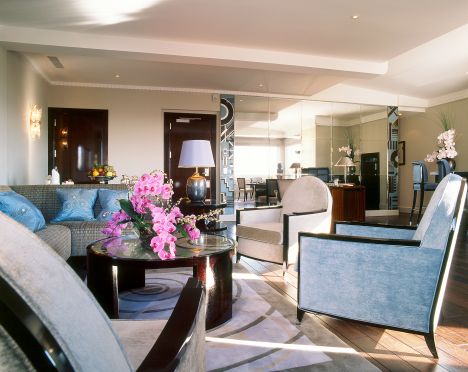
The spacious living room of my Eiffel Suite 878. Photo © Christoph Kicherer / Hotel Plaza Athénée Paris.
The new rooms and suites designed by Marie-José Pommerau
Interior decorator Marie-José Pommereau refurbished the now 154 rooms and 54 suites. Thanks to new building space added to the hotel, eight additional suites and six apartments could be created. Marie-José Pommereau used only the finest materials such as silk curtains, damask and embroideries to decorate them.
I had a look at one of the six new apartments located directly above Harry Winston, overlooking avenue Montaigne as well as at one of the new suites above Le Relais Plaza.
215 is a Prestige Suite Violet, with embroideries from the prestigious Lesage atelier. The Parisian style comes to live not only thanks to the collaboration with top couture houses but, in addition, thanks to elegant vases, sculptures and other objects Marie-José Pommereau regularly discovers in antique shops and flea markets; they give the rooms their individual touch.
For the sinks and bathtubs on the second, “Regency floor”, as well as in other bathrooms, she used luminous “Calacatta”, grey-veined white marble, sourced from Carrara. Immaculate, white marble adorn the bathroom floors and walls.
I stayed in the fabulous Signature Eiffel Suite 868 / 878. From everywhere, the lounge sofa, the salon chairs, the bar, the writing desk, the dining table, the bedroom and the bathroom, you can gaze out at the Eiffel Tower.
The bathroom features a double sink, a Hamam and steambath, a shower as well as a large, free-standing bathtub with direct Eiffel Tower view. Sophisticated, crystal-liquid technology enables you to turn the glass window opaque to ensure privacy if requested.
The Signature Eiffel Tower Suite 868 / 878 offers a masculine atmosphere. It features rosewood, Macassar ebony and mahogany woodwork, furniture and doors. The carpets with their Art Deco motifs, the heavy silk curtains with edgings re-embroidered by the Jean-François Lesage company using silver grey tones, the textiles from Pierre Frey, the cushions from Lesage, the lampshades from Boucardeau, the furniture from Laval, the mosaics made by an Italian artisan as well as the private Art Deco bar in the salon all testify to the hotel’s strive for excellence. Incidentally, my favorite part of the Art Deco bar was the selection of champagne bottles: Lanson, Billecart-Salmon, Krug, Laurent-Perrier and Dom Pérignon.
In the salon, I appreciated the handful of books, especially the monumental, 572-page, large-scale, hardcover J’aime Paris, autographed by the author and chef Alain Ducasse himself.
If you are looking for the ultimate, French luxury, which lies in details, you will feel at home at the newly refurbished rooms and suites.
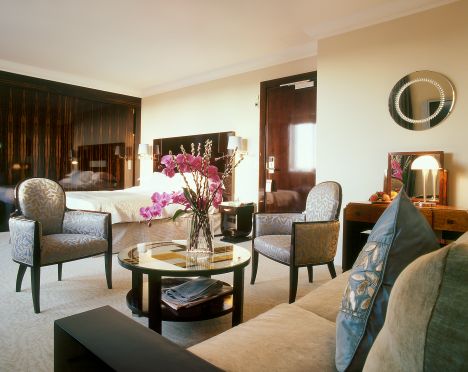
The bedroom in my Eiffel Suite 878. Photo © Christoph Kicherer / Hotel Plaza Athénée Paris.
The present-day restaurants: Alain Ducasse, La Galerie, Le Relais Plaza
The legendary chef Alain Ducasse supervises the kitchen at the gastronomic restaurant at the luxurious Plaza Athénée. During my stay, his restaurant had just been awarded two Michelin stars after its re-opening with a new concept in August 2014. Please be aware that it is closed on Saturday’s and Sunday’s. I stayed at the hotel over the weekend. Therefore, I had dinner at the hotel brasserie Le Relais Plaza instead, which is were tout Paris still meets today. As for Alain Ducasse, I just had the chance to quickly spot him in the lobby because he was in the hotel for a private tasting in the kitchen on Monday morning.
In addition, there is La Galerie, the hallway leading from the reception to Le Bar and beyond. It is open from 08:00 until 02:00 and always busy with people tasting the Afternoon Tea and the desserts by Christophe Michalak and pastry chef Jean-Marie Hiblot as well as the cuisine by head chef Philippe Marc. La Galerie features a mosaic floor, silver tones and chandeliers that visibly attracts people from around the globe to gather here at any time of the day.
Another highlight of the luxurious Plaza Athénée is the interior court, La Cour Jardin. In winter, it had been transformed into an ice rink, enjoyed not only by children. Especially from May until October, it offers a haven of tranquility. Landscape gardener Olivier Riols takes care of geraniums, crape myrtle, red camellias and Virginia creepers. When I stayed at the hotel over a February weekend, the gardeners were already busy preparing the new season.
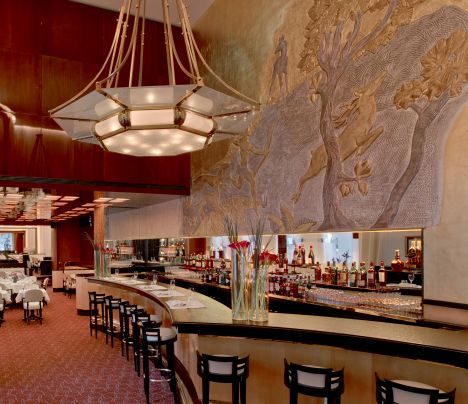
The brasserie called Le Relais Plaza with its bar and Art Deco mural. Photo © Eric Laignel / Hotel Plaza Athénée Paris.
Anecdotes from the concierge: a magical palace where dreams come true
As always, I try to get a story or two form the chef concierge regarding extravagant demands by guests. Jérôme Poret told me that a small group of Brazilians had requested some white truffles. Since that variety comes from Alba in Italy, a private jet was organized in the morning. They had a truffle lunch in Alba. In the evening, they flew back with 3.5 kg of Alba truffles. The story was brand new. Later that day, I spotted in fact some Brazilians with truffle bags in the lobby, ready to check out.
Another extravagant story took place on a rainy day, when a couple surprised their children with baby lions. The concierge organized that they could play with them in their room. A zoo had to be called, a lion’s keeper had to be present and insurance matters had to be solved.
To a larger public in the United States (and around the globe), the Plaza Athénée is known because the last two episodes of the romantic comedy TV series Sex an the City were shot here. According to a lady from the hotel’s PR department, this led to a high demand in hotel bookings for a specially created Sex and the City hotel arrangement.
In short, Hôtel Plaza Athénée in Paris is the place where everybody wants to stay, to dine or just to be seen. It is the magical palace where dreams come true.

The famous interior garden: La Cour Jardin. This winter, it was transformed into an ice rink where not only children liked to ice-skate. Photo © Frédéric Ducout / Hotel Plaza Athénée Paris.
A history of the fabulous Hôtel Plaza Athénée Paris
Hôtel Plaza Athénée opened its doors on avenue Montaigne on April 20, 1913. Initially, it was supposed to open just one day after the Théâtre des Champs-Elysées, situated in the same street. Because of a legal issue, the opening had to be delayed for almost three weeks.
The hotel name was coined by its first manager, Emile Armbruster. He had been a successful GM before at Hôtel de l’Athénée in rue Scribe. In 1913, the heirs of the owner, the banker Louis Raphaël Bischoffhseim, decided to sell the property to a bank. He needed a new job.
From 1903 until 1910, Jules Cadillat had run a hotel on the Champs-Elysées. He had the ambitious plan to create a new hotel called Plaza in avenue Montaigne. He hired the architect Charles Lefebvre, who had previously been involved in the building of the Lido as well as of Hotel Claridge on the Champs-Elysées. From 1911 until 1913, he constructed the new luxury hotel for Jules Cadillat in avenue Montaigne with a facade in the Haussmann-style.
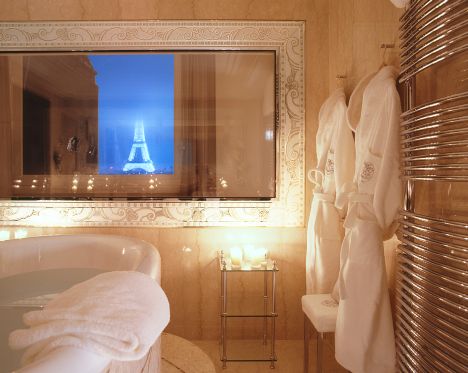
The view from the free-standing bathtub in my Eiffel Tower Suite. Crystal-liquid technology enables you to turn the silver-framed glass window opaque to ensure privacy if requested. Photo © Christoph Kicherer / Hotel Plaza Athénée Paris.
In 1913 Jules Cadillat was ready to open his hotel, the writing paper, the engraved tableware and the embroidered linen, all with the Plaza logo, were ready. However, he had forgotten to register the hotel name. A competitor attacked him on grounds of similarities between the two names. This was when the appointed Managing Director Emile Armbruster came up with a clever idea: Hôtel Plaza Athénée, which sounds more exclusive anyway.
The new hotel quickly attracted composers and artists who regularly dined here after their evening performances at the theatre; at the time, the hotel restaurant was run by chef Jacques-Léon Colombier, who had won the London Gourmet Prize launched by none other than Auguste Escoffier.
During the First World War, the Plaza Athénée was lucky to escape the fate of being transformed into a hospital. It remained open during the entire war.
In the roaring twenties, the architect Jules Lefebvre doubled the hotel area by building spacious hotel apartments, La Cour Jardin and the two salons of the time. The party ended with the crash in 1929 and the Great Depression.
François Dupré, a hotelier, art collector and horse breeder stepped in. In addition to the Plaza Athénée, he also purchased the new Hotel George V in the parallel street as well as the Hotel Ritz in Montreal. It was under the reign of François Dupré that the Art Deco restaurant Le Relais Plaza was added to the hotel by architect and interior designer Constant Lefranc in 1936. The hotel had been closed for two years to undergo a fundamental restructuration.
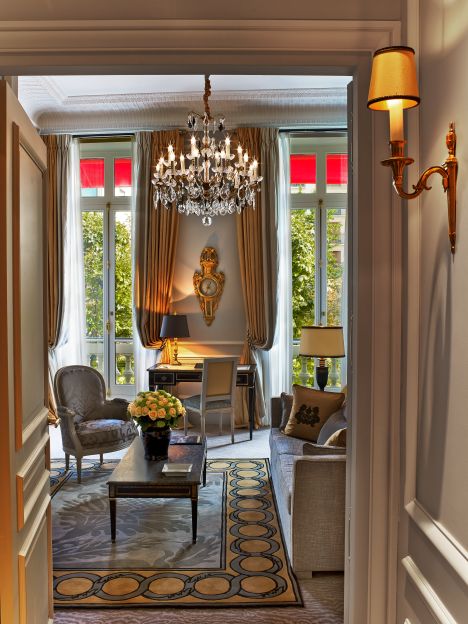
View of the Junior Suite Prestige 214. Photo © Eric Laignel / Hotel Plaza Athénée Paris.
In 1939 the Plaza Athénée was requisitioned by the occupying forces. The staff hid the hotel’s wine, silverware, linen and tapestries in a private house in rue Quentin-Bauchart. The managing director, René Lambert, was removed from his position and could only run the hotel again after the Liberation of Paris, when Le Relais Plaza became the Americans’ cafeteria. René Lambert turned the restaurant in a snack bar, serving champagne by the glass and beer on tap.
In 1947, Christian Dior set up his couture house on avenue Montaigne right next to the hotel. He became a regular. Other couturiers followed him. The street became a high fashion center and has remained so until today.
With Christian Dior, the hotel clientele changed. Fashion and art were on top. Grace Kelly, the Ford family, actors such as Gary Cooper and many more made the hotel a fashionable place.
In 1963 Georges Martin became the new hotel director. He undertook several renovations. This period ended in 1966 with the death of François Dupré.
In May 1968, student protests shook Paris. The former concierge and Communist Union member, Paul Bougenaux, organized a staff demonstration against the sale of the hotel. The new owner, Sir Charles Forte, was forced to compromise and appoint Paul Bougenaux as GM in 1969. A successful coup at the Plaza Athénée! Apparently, the Bougenaux years were economically successful.
In 1968, the Forte Group purchased the Plaza Athénée and ran it until 1996, when Granada pushed Sir Charles Forte out of his group in an unfriendly takeover. Granada quickly sold off the luxury hotels of the Forte Group, among them the Paris hotels Plaza Athénée and George V.
In 1979 Franco Cozzo became the new GM. He had worked under Bougenaux, redecorated the Plaza Athénée and later moved to Sir Charles Forte’s Plaza Athénée in New York City. The Sicilian Franco Cozzo was followed by Hervé Houdré in 1995. He came from the New York Plaza Athénée, where he had been vice-director. He had subsequently worked as director at Le Crillon in Paris. Hervé Houdré oversaw a major redesign of the hotel structure, including the air conditioning and the information technology in order to remain competitive.
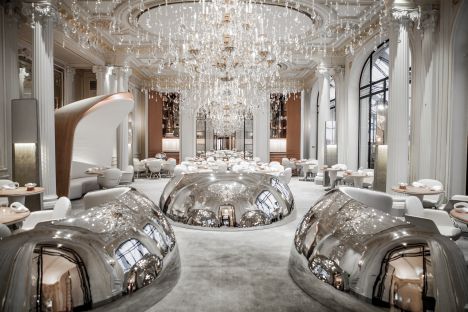
The two Michelin-star restaurant Alain Ducasse at the Plaza Athénée. Photo © Pierre Moneta / Hotel Plaza Athénée Paris.
In 1997, the Sultanate of Brunei bought the goodwill for the Plaza Athénée. From 1998 until 2000, major work was undertaken to refresh the hotel. During that time, the hotel remained open. In 1999, François Delahaye became managing director. He initiated key changes. Le Bar was redesigned in 2001. He chose Alain Ducasse to supervise the hotel’s catering services and create the menu for the new, Alain Ducasse at Hotel Plaza Athénée restaurant. In addition, François Delahaye appointed pastry chef Christophe Michalak at La Galerie des Gobelins and Philippe Marc took over as chef at Le Relais Plaza.
Alain Ducasse obtained three Michelin stars at his Plaza Athénée restaurant in 2001. After the 2013-14 shutdown for renovation and its re-opening with a new concept, the Alain Ducasse restaurant has already obtained two Michelin stars again in 2015.
In 2001, the Dorchester Collection acquired Hotel Plaza Athénée on behalf of the Brunei Investment Agency, which manages the Sultanate’s sovereign fund. The almost unlimited means helped make the hotel second to none. In 2003, the Brunei Investment Agency purchased the hotel buildings.
In 2003 the newly appointed hotel manager Laurence Bloch commissioned the interior decorators Bettina Mortemard and Marie-José Pommereau to relook the 194 rooms and suites. Two years later, a 450-square meter Royal Suite opened on the fifth floor. In 2008, the Eiffel Suites were launched. The same year, the Dior Institute opened at the hotel.
In 2012 the Plaza Athénée was awarded the distinction of palace, the ultimate achievement in luxury in France, just one year before its centenary celebration. A palaceis for instance required to have double sinks, a separate shower and bathtub in all rooms. That is just one of many high-standard requirements.
The Dorchester Collection bought three additional, adjacent buildings and integrated them in a ten-month renovation in 2013/14 into the existing hotel structure. In addition to creating fourteen new suites and apartments, the hotel’s technology was upgraded, new services were added, the above-mentioned redesign took place.
On my weekend in February 2015, the Plaza Athénée was extremely busy, including the Galerie the Gobelins, where the rich and famous gather all day, long before the opening of the gastronomic restaurant and the bar. I cannot remember having seen a luxury hotel busier than the Plaza Athénée.
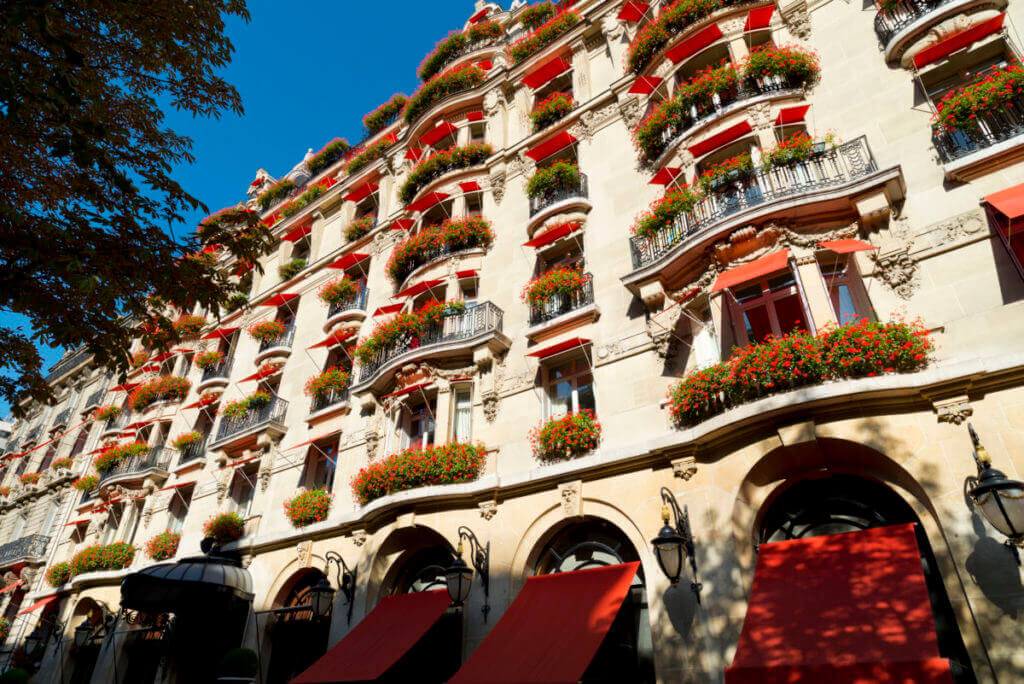
The famous facade of Hotel Plaza Athénée, situated in the glamorous, high-fashion avenue Montaigne. Photo © Masahiko Takeda / Hotel Plaza Athénée Paris.
Article added on February 17, 2015 at 01:08 CET